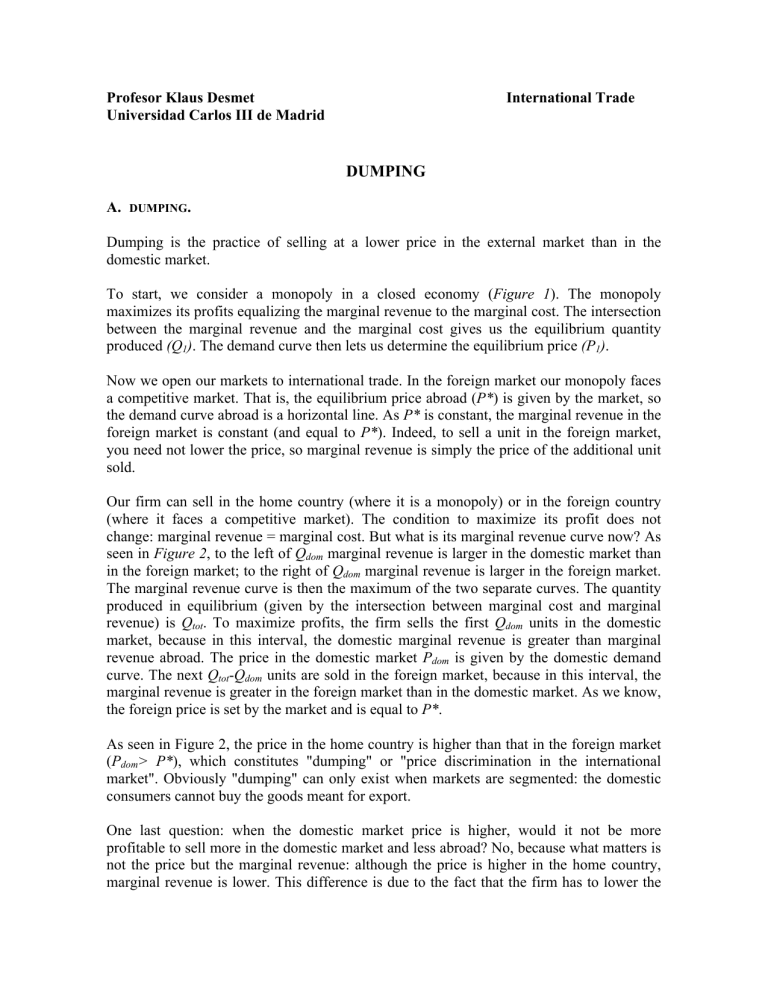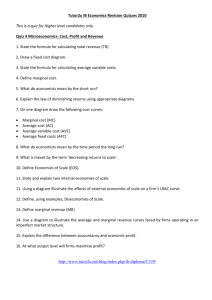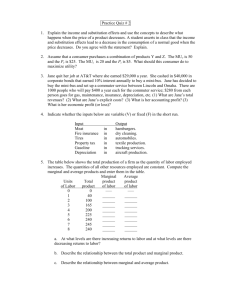dumping - Universidad Carlos III de Madrid

Profesor Klaus Desmet
Universidad Carlos III de Madrid
International Trade
DUMPING
A.
DUMPING .
Dumping is the practice of selling at a lower price in the external market than in the domestic market.
To start, we consider a monopoly in a closed economy ( Figure 1 ). The monopoly maximizes its profits equalizing the marginal revenue to the marginal cost. The intersection between the marginal revenue and the marginal cost gives us the equilibrium quantity produced (Q
1
) . The demand curve then lets us determine the equilibrium price (P
1
) .
Now we open our markets to international trade. In the foreign market our monopoly faces a competitive market. That is, the equilibrium price abroad ( P* ) is given by the market, so the demand curve abroad is a horizontal line. As P* is constant, the marginal revenue in the foreign market is constant (and equal to P* ). Indeed, to sell a unit in the foreign market, you need not lower the price, so marginal revenue is simply the price of the additional unit sold.
Our firm can sell in the home country (where it is a monopoly) or in the foreign country
(where it faces a competitive market). The condition to maximize its profit does not change: marginal revenue = marginal cost. But what is its marginal revenue curve now? As seen in Figure 2 , to the left of Q dom
marginal revenue is larger in the domestic market than in the foreign market; to the right of Q dom
marginal revenue is larger in the foreign market.
The marginal revenue curve is then the maximum of the two separate curves. The quantity produced in equilibrium (given by the intersection between marginal cost and marginal revenue) is Q tot
. To maximize profits, the firm sells the first Q dom
units in the domestic market, because in this interval, the domestic marginal revenue is greater than marginal revenue abroad. The price in the domestic market P dom
is given by the domestic demand curve. The next Q tot
Q dom
units are sold in the foreign market, because in this interval, the marginal revenue is greater in the foreign market than in the domestic market. As we know, the foreign price is set by the market and is equal to P* .
As seen in Figure 2, the price in the home country is higher than that in the foreign market
( P dom
> P* ), which constitutes "dumping" or "price discrimination in the international market". Obviously "dumping" can only exist when markets are segmented: the domestic consumers cannot buy the goods meant for export.
One last question: when the domestic market price is higher, would it not be more profitable to sell more in the domestic market and less abroad? No, because what matters is not the price but the marginal revenue: although the price is higher in the home country, marginal revenue is lower. This difference is due to the fact that the firm has to lower the
price in the domestic market to sell more (which also affects all the other units sold, the socalled inframarginal units), while it can sell more abroad without lowering prices. (More generally: to have dumping - - sell at lower prices abroad than in the domestic market - - it is necessary that the elasticity of demand for domestic producers is larger abroad than in the home country.)
B.
R ECIPROCAL D UMPING .
Consider a good that is consumed in both the countries. Each country has one firm. The two countries and the two firms are identical. In the presence of transport costs there would be no trade between the two countries if the market were competitive. In this model of duopoly, however, there might be international trade.
Consider first the economy in the absence of international trade. Each firm is a monopoly in their respective countries ( Figure 3 ), so the price is higher than the marginal cost. Since the situation is perfectly symmetrical, it is obvious that all the equilibrium variables are identical in the two countries.
Suppose that the sum of the marginal and the transport cost is less than the price. In this case the foreign firm has an incentive to sell in the home country. Indeed, the cost of the foreign firm to sell a unit in our market is the marginal cost plus the transport cost, while the marginal revenue of this unit is simply the price (since it is the first unit sold by the foreign firm in our market, marginal revenue equals price). Likewise, the domestic firm also enters the foreign market.
The foreign firm continues to sell in our market until the marginal cost plus transportation cost equals the marginal revenue. (Note that the marginal revenue will be less than the price as soon as the foreign firm sells more than one unit in our market.) The entry of the foreign firm in our market reduces the price, and therefore the marginal revenue of the domestic firm. Consequently, the domestic firm reduces its sales in its own market. In summary, there are three effects on the domestic market: (1) the price drops (2) the domestic firm’s sales fall in its own market, and (3) sales of the foreign firm increases in the domestic market. These effects are shown in Figure 4 , where z and P
1 are the quantity and price in the domestic market before the market opens up to trade, c is the marginal cost, c + t is the marginal cost plus the transport cost; x is the quantity sold by the firm in its own market after opening up to trade, y is the quantity sold by the foreign firm in the domestic market after opening up to trade, and P
2
is the price after opening up the market. (Since the situation between the two countries is completely symmetrical , y can also be interpreted as the quantity sold by the domestic firm abroad.)
Here we have an international trade situation that seems completely useless. There is trade between two countries, identical in all respects, in one good (and that in the absence of comparative advantage and economies of scale). Moreover, this trade is costly because there are transport costs. However, there is also a positive aspect: the power of the monopolies has been reduced. To determine whether the positive aspect is larger than the negative effect, one would have to do a welfare analysis.
Figure 5 depicts the domestic economy before the market opens up. Welfare can be defined as consumer surplus plus producer surplus (the sum of the two is the area above the marginal cost below the demand curve). Figure 6 depicts the same economy after the market opens up. Comparing Figure 6 to Figure 5 there is a positive effect of trade (the production increases, thanks to increased competition) and there is a negative effect (the cost increases due to the transport). Depending on which effect is larger, the net effect of international trade can be positive or negative. In the absence of transport costs, international trade would clearly be profitable.
Referencias
Brander, J. y Krugman, P. (1983), “A Reciprocal Dumping Model of International Trade,”
Journal of International Economics , 15, 313-321.
Krugman, P. (1990), Rethinking International Trade , Cambridge: MIT Press.
P
P
1
Gains
Losses x z x+y
Figure 6
c+t c
Q








